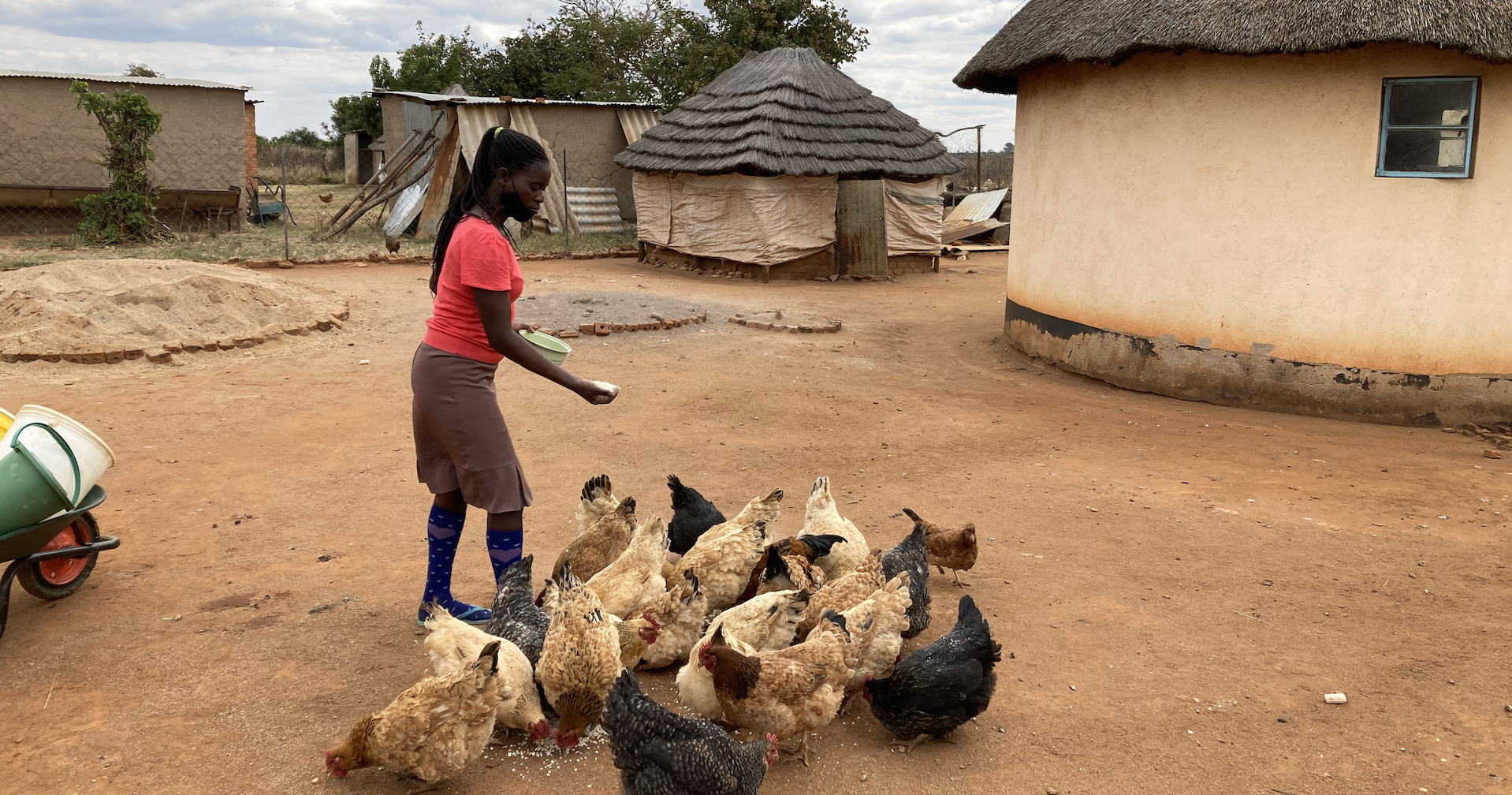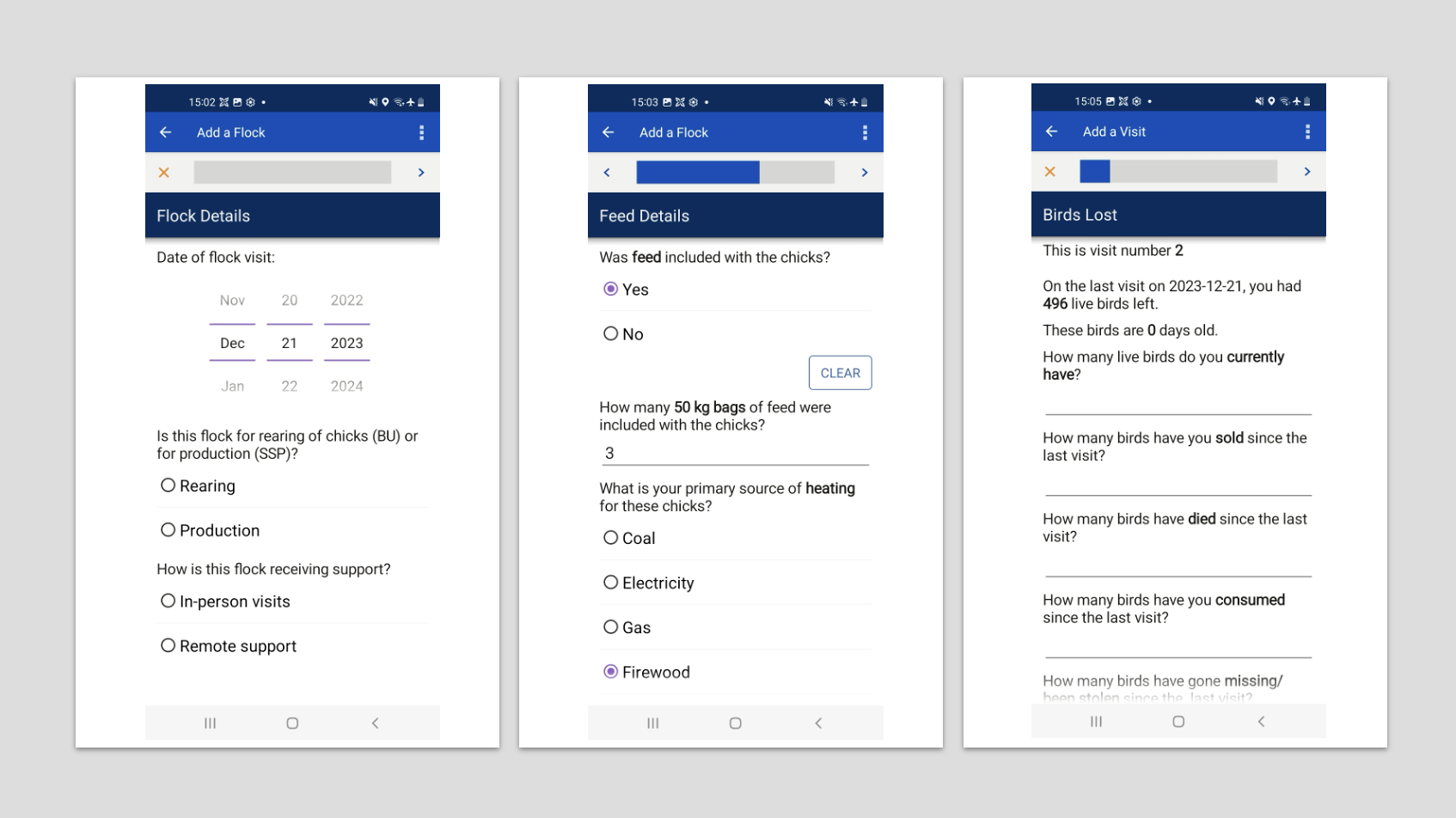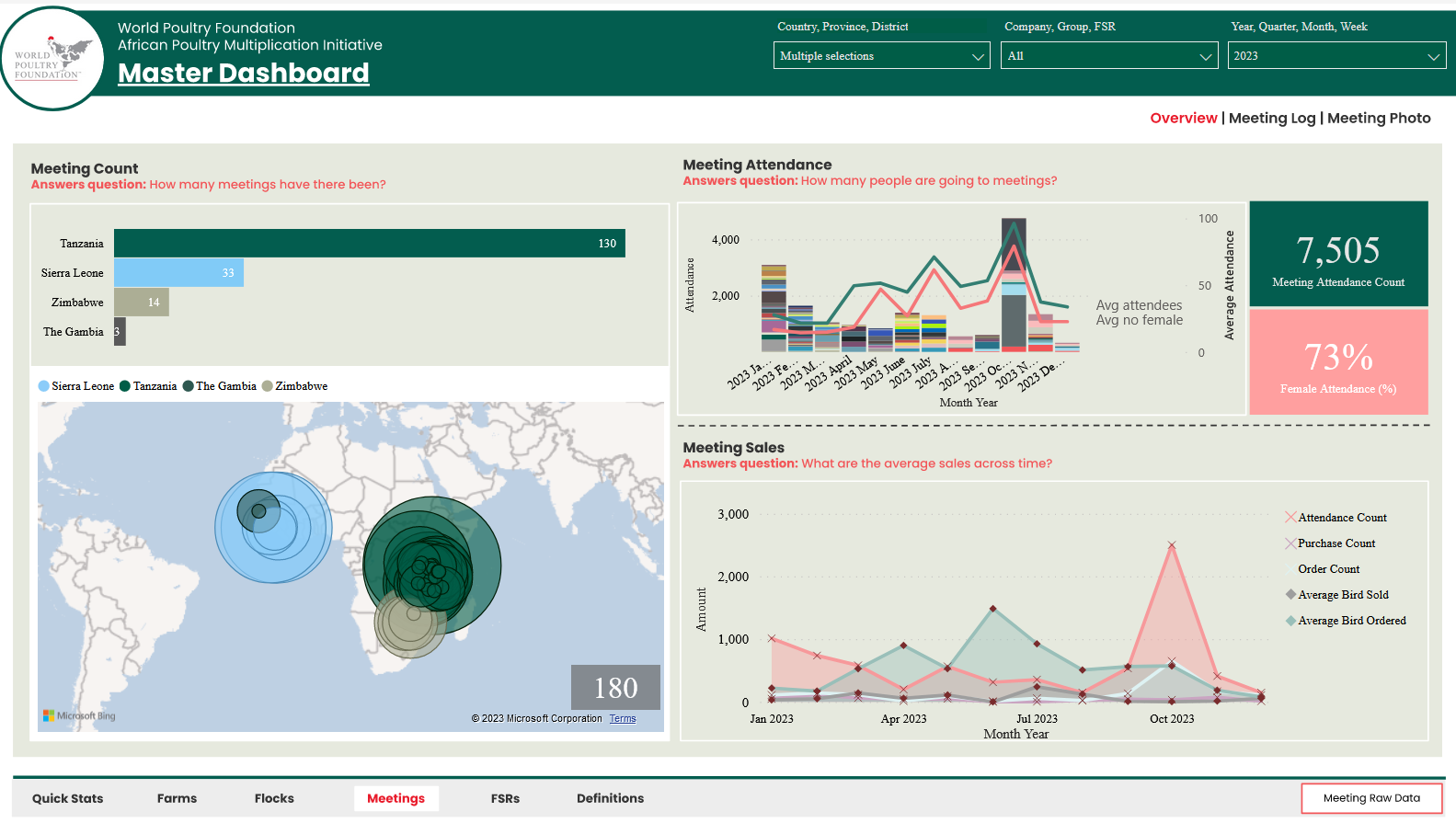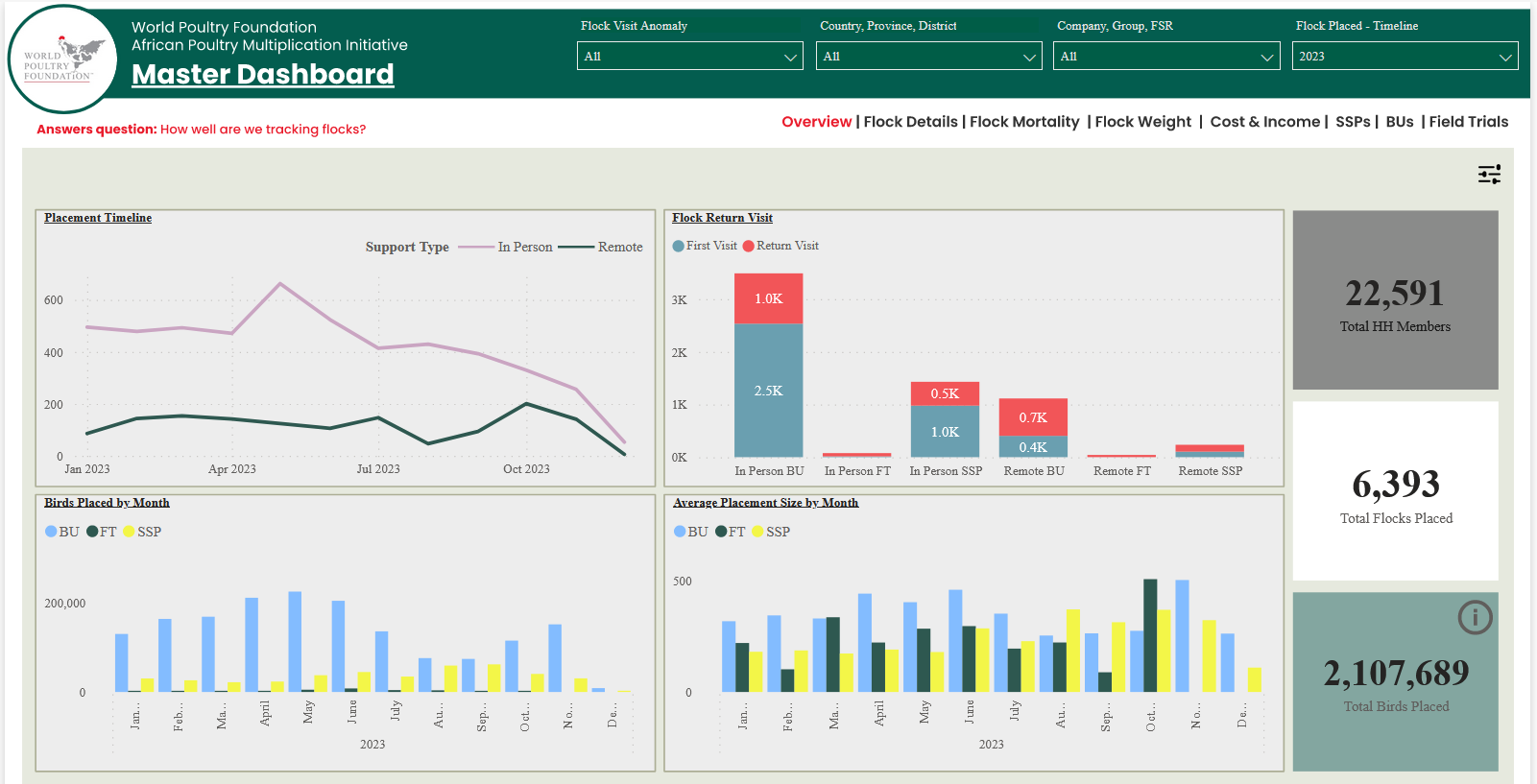World Poultry Foundation’s guide to Implementing a Self-Service Digital Solution

6 Steps to Measuring Success in Poultry Farming – a profitable initiative empowering Women in Africa
Author: Maureen Stickel, Director of International Program Development at World Poultry Foundation
Introduction
I joined the World Poultry Foundation (WPF) two and a half years ago. My role involves overseeing our monitoring and evaluation systems, external communication, and all our training support and programs. My journey with the organization began back in 2018 on a Bill and Melinda Gates Foundation Impact Evaluation initiative where I became acquainted with the challenges the World Poultry Foundation faced in obtaining real-time data from the field that they needed to understand what was happening across the organization. Collecting information from dispersed field teams, ensuring real-time information flow, and visibility to important impact indicators were common struggles, and the WPF had tried a couple of different approaches, with limited success.
To overcome these challenges, the World Poultry Foundation team embarked on a journey to find an affordable, sustainable self-service mobile digital solution. It needed to be user-friendly so that our team could design and build the mobile application ourselves without needing a team of developers. We were also looking for a sustainable approach – one that would allow us to build our internal technical capacity and ultimately take full ownership of the long term management of the solution. After considering several software tools, we decided on CommCare.
One of my initial tasks was to get the Commcare application up and running. Little did I anticipate the complexities of establishing a fully functioning digital ecosystem across multiple countries, languages, and contextual differences in order to get a comprehensive view of activities and impact measurement.
This article serves as a recount of the process we undertook to streamline operations, optimize impact, continuously tweak and improve, and foster sustainability, sharing the valuable lessons learned along the way.
The Africa Poultry Multiplication Initiative (APMI)
The World Poultry Foundation operates as a US-based nonprofit with a core mission: to enhance the livelihoods of farmers globally through engagement with poultry value chains, with particular focus on empowering women. Our work demonstrates emphasis on training and sustainability, which for us extends beyond green initiatives to also encompass financial viability.
Our collaboration involves partnering with private-sector poultry companies to develop value chains for Dual Purpose Birds. These birds are intentionally bred for both egg and meat production, selected on qualities that help them to thrive in the harsh conditions of rural Africa. This category of poultry encompasses various breeds tailored specifically to rural farmers, aimed at bolstering their income by selling chickens and eggs while providing the farmers with access to nutritious food. The initiative prioritizes the availability of healthy protein sources derived from chicken meat, and egg consumption, ultimately contributing to improved food security for these communities.
Creating a Sustainable Value Chain
In Africa, chicken rearing is often led by women, presenting significant opportunities for engaging them within the value chain. Our aim is to encourage their involvement, boost training, knowledge, and foster business opportunities. To achieve this, we collaborate with private-sector companies to expand this value chain using a tiered distribution model.
The process begins with the company producing day-old chicks, which are then sold to a brooder unit responsible for rearing the birds during their first four weeks of life. These birds are subsequently sold to small-scale producers. This tiered distribution model, akin to a hub-and-spoke system, allows us to reach remote rural areas.
Crucially, in this distribution model, the birds are sold at each stage, rather than given away, ensuring profitability at every step of the value chain. Part of the work that we do is to ensure that profitability is realized at these stages and that the birds perform as expected. This ensures farmers receive birds that thrive, lay eggs consistently, and enable them to earn profits. Our ability to track and measure these impact indicators is where Dimagi’s software platform, CommCare, plays a key role.
Impact Assessment: Numbers and Reach
In our collaboration under APMI and our partnerships in Nigeria, Tanzania, and Zimbabwe over the past five years, the work of our organization has facilitated the production and distribution of over one hundred million day-old chicks, funneling them into rural markets. This effort has led to the establishment of more than fourteen thousand brooder units.
Our estimations suggest that through these initiatives, we are reaching beyond 2.4 million rural households. This number gains even more significance when considering the average household size in these areas, amplifying the potential impact on livelihoods.
The potential for impact is significant, primarily due to the sustainability of our financial model. Post-funding, the program is designed to be able to operate within a for-profit value chain framework, ensuring ongoing growth and sustainability, even beyond our direct involvement. We are seeing success with this sustainability model in all three countries where our initiatives are already in place.
Operational Insights: World Poultry Foundation’s Approach
Our dedicated agricultural extension agents (also known as Field Service Representatives or FSRs) play a pivotal role in introducing the concept of dual-purpose chickens (birds) to communities. They arrange gatherings in local communities where they share detailed information about the advantages of dual-purpose birds: their faster growth, increased egg production, higher livability, and overall benefits compared to local breeds. The agents bring these birds to the meetings, allowing attendees to visually compare them with the local breeds.
Additionally, the agents actively engage in recruiting brooder units within these communities. Once established, these brooder units receive regular support through weekly visits from our FSRs who check on the birds’ well-being, provide guidance on proper care, and offer valuable advice to ensure optimal rearing conditions. This hands-on support is crucial in ensuring the success and well-being of the birds at this critical stage.
Utilizing CommCare for M&E, and Service Delivery
CommCare contributes significantly on two crucial fronts:
- Meeting Tracking and Brooder Unit Performance: It helps us trace meeting attendance and locations in remote rural areas and villages, identify areas with high demand for birds, and decide where additional brooder units might be most beneficial.
- Tracking Brooder Units’ and Small-Scale Producers’ Productivity and Profitability: Commcare allows us to monitor farmer experience and bird performance at the farmer level. Are we observing low mortality rates? Is bird growth on track? Are the birds being sold further into the market healthy and thriving? Additionally, we track metrics such as egg production and growth among small-scale producers to ensure they are reaping benefits from these birds.

The app’s geo-coding feature allows us to map farmer locations and even track our FSRs’ movements. This feature has been incredibly useful to partners by helping them to estimate the logistics for their FSRs such as the allocation for fuel for transportation, making forecasting and budgeting easier. They have been able to better understand their farmers’ needs. An example of this is where a partner adjusted their drop off points for day old chicks in cluster hubs and centralized pick up points as a result of this GPS data. This accountability data helps ensure that agents are providing the necessary support to help farmers thrive. Using CommCare, these agents can easily check-in and out, and log information when they visit farmers, streamlining data collection without the need for dedicated survey enumerators. The logged check in and check out information has been used by partners to help measure effort of FSRs to support appraisals.
CommCare’s simplicity and versatility as a mobile digital solution, supports multiple languages and key functionalities, even in areas with low bandwidth or no network coverage on a low-cost android mobile phone. The ability to save forms offline and upload them once an internet connection is available, coupled with accurate GPS location and timestamps, addresses key challenges, making data collection seamless and reliable, even in remote areas.
Data Dashboards for Impact Evaluation
We partnered with OiKoi – a member of Dimagi’s provider program that’s highly proficient in building apps on CommCare, to unveil our latest application version. This iteration automatically integrates with Power BI, offering real-time dashboards accessible from any device. Granting access to the companies we collaborate with has empowered them to efficiently manage their field teams and expansion into new geographic areas within the countries where they operate. These dashboards have proven instrumental for the companies we work with, aiding in enhanced operational management across various levels. The graphs encompass a wide range of details and provide robust comparisons, such as evaluating the performance of an FSR against the average of their peers or tracking a farmer’s progress across different flocks. Partners leverage this information for their periodic reports, facilitating data-driven decision-making.
Field Service Representative view:
The dashboards offer insights into the marketing meetings that are happening, attendee numbers and demographics (especially women attendees, which is our target market). Images gathered during field visits, showcasing bird growth, poultry houses, meetings, and attendance sheets, are accessible at the central level through dashboards. This serves to bridge the gap between central-level data users and those at the grassroots level. From this data we can deduce if the meetings are well supported or if we need to increase the messaging and promotional content to help explain the benefits. We can track if agents visit farms as planned, and evaluate the level of support provided to farmers. Additionally, we can compare agent portfolios to discern their performance, sales, and unit renewals.

Farmer view:
The data provides visibility into new farm placements, renewals over time, and diverse filters to assess farmer progress. It helps us understand the well-being of farmers and their birds, answering key questions such as:
- Are the farmers thriving?
- Are their birds healthy and laying eggs?
- Are the birds getting sold? Are they being consumed or given away?
- Are the eggs being consumed?
- Are there points of constriction in the value chain that we need to understand early on and address, rather than waiting for end line results?
The answers to any of these questions provide us with indications on where to delve deeper or prompt further inquiries if we encounter issues.
Bird Performance:
We can compare performance across different breeds of birds, too, and run trials to compare the bird performance by collecting the data through CommCare. We are also doing different egg comparisons by breed, so we can see egg action by hand. When we’re looking at flocks themselves, we can see placements over time, and return visits that are happening.

Organization Perspective:
For the World Poultry Foundation, these dashboards offer a comprehensive operational view. We’re interested in performance indicators such as the percentage of female farmers or youth farmers reached, and tracking farmer success across each geography. Cross-country comparisons across our programs in Tanzania, Zimbabwe, Zambia, Gambia, and Sierra Leone allow us to learn from successes and challenges across diverse contexts. (Note: Nigeria operates on a separate platform, and we piloted it in Congo briefly.)
Outcomes of an Integrated Digital Ecosystem
Before integrating CommCare, we lacked access to baseline data, hindering our ability to gauge success. Nevertheless, one of the most significant achievements has been our newfound ability to track farmers’ locations, activities, sales, and areas of growth over time. This has been fundamental in achieving our initial business objectives, facilitating smoother rollout, effective team management, and driving success on crucial business fronts.
As of the current update, we’ve successfully trained over 260 app users on CommCare, utilizing it daily for data collection. This enhanced data visibility has proven instrumental in shaping and bolstering key business strategies:
- Marketing Strategy: It guides our FSRs’ marketing strategies. For instance, if we notice a lack of profitability among farmers or if brooder units are holding onto flocks longer than intended, we can intervene by initiating conversations to understand and address these issues or organize more meetings to boost awareness and stimulate demand among our customer base.
- Breeding Strategy: The data empowered us to recommend additional breeds to our program, validated through rigorous field trials. This comprehensive insight has been invaluable in diversifying and optimizing our approach.
- Investment Strategy: We’re presently pursuing additional funding for growth, and having the ability to showcase to potential donors the impact they’ll witness with their investment, coupled with our cost-effective approach, has become a significant selling point. Our dashboards have piqued donor interest, emphasizing the depth of detail and impact transparency achievable through their support.
Expanding Reach and Capabilities
Our ongoing efforts involve initiating programs in Gambia and Sierra Leone, supported by funding from the Qatar Fund for Development. Discussions are underway to extend these programs to various other African countries, too.
Working closely with OiKoi, we’re in the process of developing a new application to streamline the monitoring of parent stock farms and hatcheries. This includes close management of the flocks and activities responsible for DOC production, a relatively new initiative for companies in Sierra Leone and The Gambia. This data-driven approach aims to enhance the day-to-day management of these facilities for optimized operations.
CommCare continues to be our tool of choice for partners in new territories. It plays a crucial role in aiding effective management and deepening our understanding of the effects of investments made with private sector companies. Our collaboration with donors relies on CommCare-generated data for comprehensive reporting, ensuring transparent communication of the impact derived from their investments in fostering positive changes within poultry value chains.
Advice for organizations looking to leverage technology to streamline their poultry operations:
We don’t claim to have all the answers, but we have diligently taken the time over a number of years to learn, iterate and develop a digital ecosystem that works really well for our business, providing critical insights and visibility into the key indicators. For anyone looking to leverage technology for their business, there are a couple of steps we’d recommend following:
Step 1: Choose the right technology, people and processes.
When choosing the right data collection platform for your organization, it’s important to find a partner that understands the context and complexities of data collection and service delivery, particularly the way in which the users responsible for doing the work will need to navigate challenges in the field. Opting for an intuitive platform that’s user-friendly and user centric is a good starting point. Key features like Case Management, allowed our field staff to register a case once, then simply update the case file during follow up visits. Field staff can also review case information on their mobile device, even when offline, to inform data collection and improve service delivery. Case data and aggregated form submissions can be accessed remotely for analysis and reporting, allowing us to seamlessly track subjects and analyze changes over time.
We’re a small team with strategically allocated roles. We have a Database Manager and a Data Analyst for backend management, and maintaining backup dashboards in Excel with Power Pivot and Power Query. Our Monitoring and Evaluation Coordinator provides day-to-day CommCare support and collaborates with partners to utilize Power BI for data analysis.
Beyond M&E, our team includes poultry experts, a technical director advising on bird care, and a training coordinator designing materials for FSRs. Collaborating with various technical partners has strengthened our team, allowing us to create a cohesive process.
Step 2: Build a digital ecosystem that works.
Be prepared for a longer timeline than expected to get your platform running smoothly. Break the project up into smaller segments and prioritize crucial data for an initial rollout.
When dealing with multiple countries, languages, and varied contexts, expect challenges in aligning different components smoothly. Changes might disrupt the system, and the learning curve is steep, especially when aiming for consistent measurements across diverse locations.
The initial focus should revolve around ensuring the platform operates effectively. Rigorous testing prior to field deployment is essential, although you can still anticipate the possibility of encountering errors. Take a step-by-step approach to manage the project effectively, prioritizing the most important data you need first and then building on that foundation.
Step 3: Train users well on how to use it.
Much training and upskilling is required across multiple teams, because you’ll need in-country partners to understand the technology and how to pull valuable insights, while the FSRs will need to understand what they’re collecting and why it matters. All these different pieces need to work together in tandem.
The other thing to think about is the training with FSRs where it’s valuable to watch the data really closely at first in particular, to correct errors. The lesson is that it’s a continuous improvement process. You’ll have turnover with new people joining, too, which means going back to training basics all over again, even after the program has matured. We created a series of training videos on YouTube to help facilitate virtual training when in-person sessions aren’t possible. YouTube also then allows for auto-translated subtitles with a wide variety of languages.
Step 4: Once trained, have the users use it regularly.
Once teams have been trained, the next step is to encourage consistent usage among the users. Once everyone is onboard, the focus shifts to examining and refining the data because unforeseen issues are inevitable.
Even with thorough testing—simplifying its build, comprehensive field tests, meticulous data review, and subsequent testing—there will likely be unforeseen challenges. Users might encounter issues that weren’t initially considered, leading to unexpected hiccups. Additionally, there might be unanticipated data cleaning requirements or user scenarios that weren’t previously accounted for, demanding time and effort to address.
Addressing these unanticipated data quality concerns is imperative. Continuous learning, improvement, and iterative enhancements are an essential part of the process.
Step 5: Encourage stakeholder adoption of dashboards.
Increased usage leads to error identification, prompting improvements that ultimately enhance data quality, but we know first hand how hard this can be to get right. Our Monitoring and Evaluation Coordinator drives user adoption, and actively involves companies in regularly utilizing the data.
We also encourage central data users to capture screenshots of specific graphs and share them with FSRs through WhatsApp for easier viewing. This facilitates probing the narrative behind the quantitative data and enables them to ask questions about their performance. Engaging in this practice allows FSRs to grasp the critical role they play in the overall program.
Within CommCare, our aim was to automate these feedback loops. By integrating OiKoi for dashboards, we can see the entire value chain from data collection to comprehensive visualization at the company level. This setup enables real-time field feedback and establishes an automated pipeline for data cleaning and visualization. A key learning here is that the automation isn’t entirely seamless – no platform is void of the need for oversight. That said, now that we have CommCare, the data flow is significantly more automatic than it used to be.
Step 6: Evaluate the impact and make data-driven decisions.
The dashboards provide valuable, regularly accessible information, particularly for team management purposes. In CommCare, we aimed to incorporate outcome indicators, enabling us to assess progress without waiting for a lengthy five-year endpoint. These indicators provide ongoing insights into whether our implemented changes align with desired outcomes. This approach allows for continuous feedback, facilitating course corrections and improvements along the way.
Considerable effort has been dedicated to refining and enhancing the application, focusing on elevating data quality—a persistent concern. We’ve worked extensively on integrating more checks and automated rules to ensure we’re collecting clean data right from its entry point. As we transition from the developmental phase, our focus now shifts towards deeper analysis, leveraging the comprehensive dashboards we’ve constructed.
I hope that you have found this guide and set of tips helpful as you consider the unique digital solution needs of your teams.
Technology has immense potential to help organizations do more with less – and it is largely failing to do so today. In order to do better, more and be sustainable, organizations need to collect data, meet project needs and goals and deliver impact. To meet tomorrow’s challenges, organizations need to collect better data, AND, deliver better services.
Reach out to Dimagi if you would like to learn more about implementing your own sustainable mobile digital solution to support your programs.
Share
Tags
Similar Articles
Tackle Africa - The CommCare Grant Awardee on Transitioning from Paper to Digital
Explore the impactful work of Tackle (formerly TackleAfrica), a renowned NGO leveraging football to deliver HIV and Sexual & Reproductive Health & Rights (SRHR) information and services to young people across Africa, and learn about their transition from paper to digital data collection through the CommCare Research Grant.
Dimagi Partner Blog
April 19, 2024
Amplifying Early Childhood Development with CommCare: FCW's Digital Transformation
The FCW Early Childhood Development program provides home visitors with training on how to leverage CommCare for digital transformation
Dimagi Partner Blog
April 11, 2024
World Poultry Foundation’s guide to Implementing a Self-Service Digital Solution
Learn how the World Poultry Foundation addressed challenges in collecting real-time data from the field. Explore their journey to find an affordable, sustainable mobile digital solution and gain valuable insights along the way.
Dimagi Partner Blog
January 26, 2024